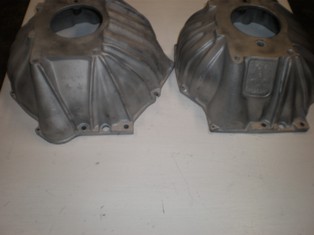Chevy Bellhousings
People commonly define Chevrolet Bellhousings by the Clutch size i.e. (10.5",11", or 12").
Flywheel Diameter (12.75" or 14") or number of teeth is more accurate because
some 168 tooth flywheels are drilled with multiple bolt patterns and the aftermarket
makes a 153 tooth flywheel that a 11" clutch and pressure plate will fit.
Chevrolet has always had just two sizes of flywheel Big (168 tooth 14"
diameter) and Small (153 tooth 12.75" diameter) with the 153 tooth
flywheel being introduced in 1963.
The early bells were cast iron with the aluminum bells being fazed in and eventually the only material for all factory bells.
With that said most Chevy Bells will physically fit Small blocks from
1955 on up, 6 cylinders from 1963 on, and all Big Block engines, W
engines, as long as they are Chevrolet engines. GM used engines from
other divisions in Chevy cars. But there are major differences
to consider such as transmission mounting hole size, clutch fork ball
stud locations, z-bar mounting provisions, starter, clutch fork hole
location and of course Factory correct application.

168 tooth 153 tooth
In the above photo you can see the difference between the starter sides
of the two aluminum housings. On the 168 tooth Bell the starter is
farther away from the crank center line and therefore needs more room
in the bell.
Paint:
Most Chevy bellhousings I've come across were panted while attached to
the engine and transmission, and have over spray in various places on
the inside (starter hole,fork hole) with the outline of trans mounting
ears on the front. This isn't heavy just over spray.
Inspection covers:
I've found three different sizes for aluminum bells. 153 tooth,168 tooth and truck.
But there are variations in the starter hole.
Date codes:
Most cast iron bells have an alpha numeric code. Aluminum bells? I saw
discussion on a forum that the single number over the part # was
a date code which I doubt. Manufacturers usually put a number in molds
and dies to help with quality control as in (number seven cavity needs
maintenance).There are one or two circles divided in half that are
Engineering codes and may contain some sort of date code.Some bells
have a graph looking thing with dotes also I will try to research
these. Date coded parts are cool but not all parts have date codes.
Descriptions of part numbers.
| 
